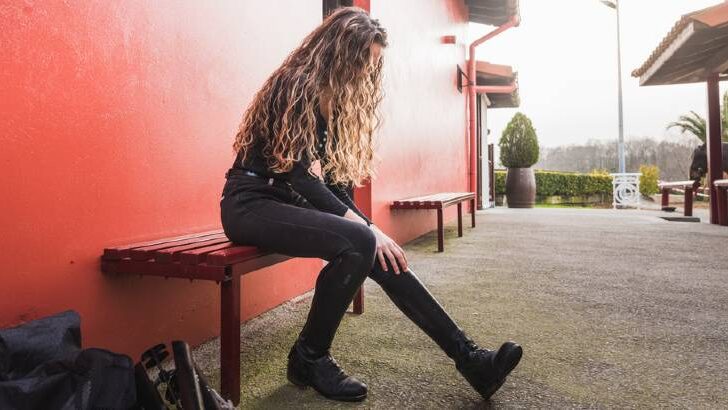Affiliate Disclaimer
As an Amazon Associate I earn from qualifying purchases. It helps me keep the website going. Thank you for your support.
I am prone to getting knee pain when horse riding. I’m generally okay when I’m riding in the school. But as soon as I go on a long trail ride, my knees will start aching. For ages, I thought that I was alone with this problem. However, after doing some research to find a solution I realized that many horse riders have a similar issue.
Knee pain when horse riding can be caused by tight hamstrings, underdeveloped muscle groups, poor posture, stiff ankles, saddle and stirrup design, your clothing, and your horse’s physique. Luckily, there are a number of things you can do to address this common problem.
You might find that your knee pain is the result of a combination of any of the issues described below. I had to experiment with a few adjustments before I found a solution that worked for me.
Or, you may be lucky, and you might find that changing one thing gets rid of the problem for you.
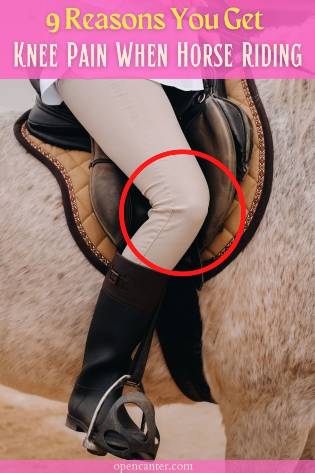
Disclaimer: I’m a Horse Rider Not a Medic
Before I go on, I should say that I’m not a medic, and I’m not a physiotherapist. I’m just a rider, who had an issue with knee pain, and who has managed to find a way of fixing the problem for myself.
If you have knee pain when you are horse riding, I would recommend consulting a doctor or a medical specialist of some kind. They would be able to identify if you have any underlying mechanical or medical issues that need attention.
That being said, these are some of the things that I have learned about the underlying causes of knee pain when horse riding.
The Causes of Knee Pain When Horse Riding
It’s a good idea to get a handle on what’s causing the pain in order to choose the right solution for you. Let’s take a look at some of the possible reasons why your knees are hurting when you horse ride.
1) Tight Hamstrings
Lots of muscles from around different parts of the leg and hip are connected to your knee joint. For example, the calf muscles on your lower leg are attached to your knee joint. Likewise, the quad muscles on the front of your thigh and the hamstring muscles located on the back of your thigh are connected to your knee.
In addition to this, there are muscles in your hips and pelvis that affects how the knee functions. These include the glutes, the hip flexors, and even the abdominal muscles.
The way that these groups of muscles work together, needs to be in balance. If they are not working in balance, an uneven strain is put on the knees. When one group of muscles is over or under-working, this can aggravate the knee joint (source).
If your hamstrings are tight, then this can lead to muscle imbalance. In turn, this creates strain on the knee. So, when you horseback riding, tight hamstrings can create pain in your knee.
Hamstrings can become tight because they are compensating for other muscle groups that aren’t working as they should. For example, if your glutes (buttock muscles) are not strong enough, or are not working as they should, the hamstring muscles will start to overwork and become overly tight.
Solution 1- Stretching, Is It Helpful?
If you think that you have tight hamstrings, it’s natural to assume that stretching them out is going to be helpful. However, sometimes stretching muscles can be counter-productive. Gentle stretching may give you some short-term relief. However, if you over-stretch your hamstring this can cause injury (source).
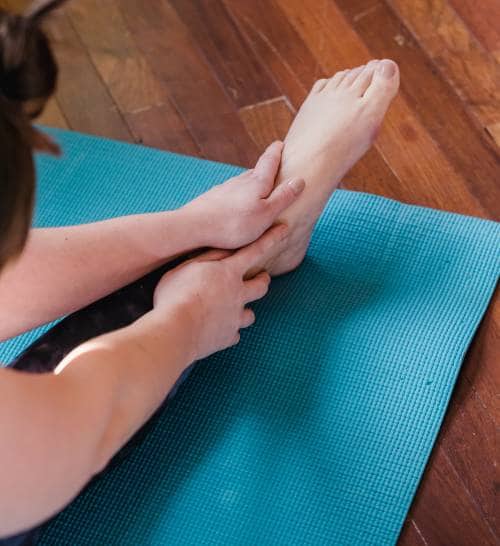
One of the reasons for this is that when you stretch your hamstrings aggressively, the muscle will contract to protect itself. Because the muscle is contracting, you might end up stretching the tendons or damaging the muscle in some way.
Sometimes, to improve tightness in your hamstrings, you need to work on the other muscle groups. It may be that your hamstrings are overworking, to compensate for other muscle groups that are not doing their job.
If this is the case, then working on the other muscle groups, will relieve the amount of pressure that is being placed on the hamstrings. This is why, it’s a good idea, to get an assessment by a trained physical therapist.
If you suspect that your hamstrings are tight, a physiotherapist will be able to do an overall assessment of each of your muscle groups. And they will be able to give you informed advice about which muscle groups to work on, and what stretches to do.
2) Weak Muscles
One other suggestion that I came across when I was doing some research to address my own knee pain was that it was caused by weak leg muscles. In particular, it’s often suggested that the muscles around the knees need to be built up to support the knee joint.
Because I was nervous about putting any additional strain on the muscles around my knees, I decided to check this out with a couple of experienced riding instructors that I know.
Both of them agreed that whilst having strong leg muscles can help with your riding form, they echoed what was said in the section above. Namely, they both pointed out that lots of different muscle groups affect how your knee works, and these other muscles need to be worked on too.
One example of this is the gluteus medius muscle. This muscle is located in your hip/buttock area. It’s one of the main muscles that control leg abduction, which is the motion of moving your leg outwards. If your gluteus medius muscle is weak, it can cause your thigh to turn inwards. This in turn puts a strain on your knee joint (source).
You may not be aware of the strain being put on your knee whilst you are doing everyday activities such as walking or sitting. However, when you get on a horse, additional strain is placed on your knee. And the combination of these two factors can make you acutely aware of any underlying knee issues you might have.
Solution 2 – Developing Muscle Strength
Overall physical fitness and muscle strength are important for most sporting activities including horse riding. And it may be that working on strengthening the muscles on your leg around the knee will help with knee pain.
However, as mentioned above, it may not just be your leg muscles that need to be strengthened. The leg has lots of different groups of muscles, and your abdominals and your glutes also affect the amount of pressure put on your knee joint.
So, as with stretching, it is worth consulting a physical therapist to help you identify which muscle groups are underperforming. This will give you a reliable picture of which muscles to strengthen to support your knee joint.
It does cost money to have a few sessions with a physical therapist. However, in the long run, it will be worth it, as it may be the very thing that you need, do you avoid experiencing riding-related knee pain.
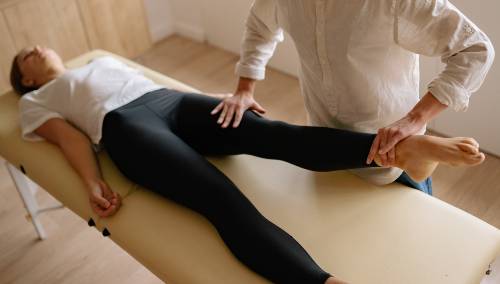
3) Gripping With Your Knees
If you are sitting well in the saddle, your position will feel secure and you will feel balanced as you are riding. This is known as having a secure seat. When your seat is secure, you move easily with the motion of the horse.
There are lots of factors that affect whether you have a secure seat. It can take some time to learn how to sit deeply and well in the saddle. And whilst you are learning it’s not uncommon to be a bit wobbly and unbalanced on the horse.
One of the ways that riders can compensate for feeling unbalanced in the saddle is they grip on with their knees. This can feel uncomfortable for the horse and restrict the horse’s movement. It can also confuse them about what you were asking them to do.
In addition to being awkward for the horse, gripping with your knees also creates tension and discomfort in your knee joint.
If you have knee pain when horse riding, it’s a good idea to consider whether you are gripping with your knees. Sometimes the gripping can be hard to spot. You may be subtly tensing up your knees as you ride. Pay attention to this area next time you ride and try and get a sense of whether you are gripping on to stabilize yourself.
SoIution 3 – Improving Your Seat
Improving your seat is a skill that will develop over time. There are lots of things that you can do to help yourself get a more secure seat. For example, make sure you have good riding posture.
Good riding posture does not mean sitting poker straight in the saddle. Instead, it means sitting with your shoulders back, with a neutral spine.
Ideally, your shoulders should be in line with your hips and your heels. With your weight evenly distributed on your sit bones, with your pelvis neither tipping forward nor backward.
Staying relaxed, and breathing deeply into your diaphragm, rather than breathing up into your shoulders, can help maintain a good seat.
When you have a good seat you are making contact with the horse through your bottom and your inner thighs.
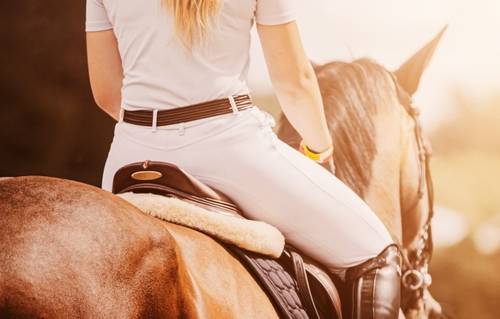
The best way to improve your seat is a combination of practice and getting instruction from an experienced teacher. Improving your seat can feel impossible and mysterious when you are starting out. But with practice and patience with yourself, it will come.
As your seat improves you should find that you need to rely less on gripping your knees to keep you upright in the saddle. This in turn will help to reduce any knee pain that you might be experiencing.
4) Your Feet and Ankles
When you’re riding it’s important that your heels are down, and your ankle is flexible. If your heels are up and your ankles are rigid, this can cause you to grip with your feet and your knees.
If you are permanently gripping your horse with your feet and ankles, it can cause the horse to become unresponsive. This is because they become immune to the pressure on their side, and they can’t tell when you are applying an aid.
Also, your ankles act a little bit like shock absorbers when you ride. If your ankles are flexible, as you move in the saddle, they will flex and absorb some of the impacts of the horse’s movement.
But if your ankles are rigid, they don’t work as shock absorbers. This in turn increases the amount of impact that your knees need to absorb as you are riding. So, it’s important to work on the position of your feet and flexibility in your ankle.
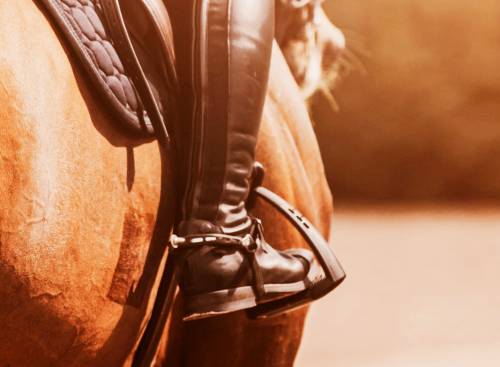
Solution 4 – Keep Your Heels Down and Ankles Flexible
When you first get on your horse, try doing some exercises that will improve the flexibility in your ankle.
One way to do this is to simply push your heel down up and down gently in the stirrup a few times. Doing this every time you get in the saddle will help to improve the flexibility of your ankle.
In addition to this another way to improve flexibility is to let your leg hang loosely without the foot in the stirrup. As it hangs loosely by your side draw a circle with your toes.
Draw the circle one way and then change direction and draw it the other way. You can do this whilst you’re sitting in the saddle, or whilst you’re sitting in a chair.
It’s important to remember, that we are all physiologically different. And some people will naturally be able to achieve greater flexibility in their joints than others.
So, without wanting to sound like a broken record, getting some advice from a PT about exercises that can help you enhance the flexibility in your ankle is a good idea. Most of us get a little bit less flexible as we get older. You can read more about learning to horse ride later on in life here.
Learning to keep your heels down, and your feet forward rather than sticking out as you ride takes time and practice.
But it’s important to be aware that your foot position will have an impact on how your knees feel as you ride. And that focusing on your foot and ankle as you continue to learn will help ease the pressure on your knee joint.
5) Saddle Design and Stirrups
If you own your own horse, then you will be able to decide what kind of saddle to use. However, if you usually ride horses at a local stable where you’re having lessons, then you will have much less control over what saddle the horse is wearing.
So, depending on your circumstances this factor may or may not be something that you have any control over.
If you are lucky enough to own your own house, then it’s important to understand that your saddle needs to fit you and your horse. The two of you are working as a team, and the saddle also needs to be comfortable for you.
Saddle design does have an impact on your experience of knee pain when horseback riding. In particular, it is quite common for riders who use a Western-style saddle to experience issues with their knees.
One of the reasons for this is that the stirrups on the western saddle are attached to a wide, sometimes stiff piece of leather called the fender. The fender has a tendency to hold the stirrup in a position that is flat against the horse’s side.
So, in order to position your foot facing forward in the stirrup, you have to twist the stirrup and the leather fender with your foot. The continual pressure, of holding the stirrup at a 90° angle to the horse’s body, can put pressure on your knee.
Solution 5 – Adapting Your Tack
There are various ways that you can adapt a Western-style saddle to reduce the strain on your knees. One way is to gradually encourage the leather on the saddle to twist outwards so that it holds the stirrup in the right position for your foot.
There are a number of ways of doing this. One method is to twist the fender and stirrup in the direction that you wanted to go and secure it in that position overnight whilst you’re not using the saddle.
You can also add stirrup turners to your Western saddle. As the name suggests, they turn the stirrup so that they naturally fall into a position that is comfortable for you. They also make it easier for you to find your stirrup if your foot comes out at some point when riding.
Another method is to switch the stirrup out on your saddle for English-style stirrups and leathers. These are thinner and turn more easily with the rider’s foot. As a result, English-style stirrups and leathers create less resistance on the rider’s leg.
Having said that, I ride English style, and even with the thinner and more flexible stirrup leathers on an English saddle, I still experienced knee pain. An alternative solution is to invest in some stirrups that are designed to reduce strain on the knee. Some stirrups are designed so that when they hang from the leathers they are sitting at a 90° angle to the horse.
Alternatively, MDC make a range of stirrup irons that twist and lock in the position that you want them to be in. And they make some with flexible rubber sections to absorb some of the impact from horse riding.
6) How Wide is Your Horse?
It may sound obvious, but the wider your horse the more your legs are going to have to stretch and bend to wrap around the horse’s side.
Horses come in all sorts of shapes and sizes, and some breeds have what is called a wide barrel. The barrel of a horse is the body of the house including its rib cage and major internal organs.
Our knee joints are designed to hinge in one direction, that is, back and forward. Any lateral movement can put pressure on the joint. By its very nature riding horses involves applying the leg from the side.
The pressure this puts on your knee joint might be intensified on a horse with a curvier barrel.
Solution 6
If you suffer from knee pain when horse riding, this may be an important factor to bear in mind if you were thinking of buying a horse.
Equally, if you ride horses at a local riding stable, you could mention to them that you have knee pain when they are deciding which horse you should ride.
Although it might feel awkward to ask, you could specify that you’d prefer to be allocated a horse that was slimmer in the barrel.
7) How Long Are You Sitting in The Saddle?
Knee pain when horseback riding is quite an individual experience. For some people, it is constant and happens as soon as they get on their horse. For others, it is something that happens once they’ve been in the saddle for a while.
Personally, I tended to get knee pain once I’d been in the saddle for a couple of hours. I was okay in the riding arena, but as soon as I went on a long hack my knees would start to bother me.
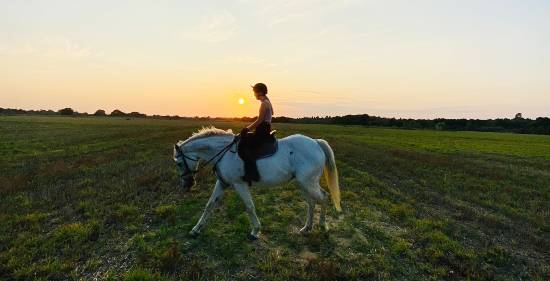
Here are some things that you can do when you’re actually in the saddle and need a bit of immediate relief from the discomfort.
Immediate Solutions
If you find that your knees are hurting, the first thing to do is simply take your feet out of the stirrups and let your legs dangle down in a relaxed way. If you’re going on a long ride, you can do this every 15 minutes or so, and it can make a big difference.
Another alternative, when you’re out and about, is simply to dismount and walk for a period of time. This will give you and your horse a bit of a rest.
One of the things that I have found helpful, is to build my stamina gradually. If you are used to riding for around an hour or so in the arena, and you suddenly switch to doing day-long trails, your knees may start to complain.
If you want to do long rides, like any kind of exercise, it’s a good idea to build up your fitness level slowly. You can gradually extend the length of time you spend in the saddle, and you might find that this will be less aggravating for your knees.
Another handy technique that I came across is described by physiotherapist and rider Nikki Robinson. She has a book called Pain-Free Horse Riding, which I would recommend.
She describes one of the techniques that she uses for immediate relief from knee pain. It involves gently but firmly pressing down on the muscle group above the knee, whilst you are sitting in the saddle.
8) Clothing
This is another factor that may seem obvious once you’re aware of it, but it’s easy to overlook. Wearing unnecessarily tight or poorly fitting legwear will put pressure on your knee and can cause knee pain when horse riding.
Solution 8 – Overhaul Your Riding Wardrobe
Think about what you wear when you’re in the saddle. Are your jodhpurs or breeches too tight around the knee? When you sit down in them, do they stretch and strain across your knee joint? Or do they bunch up uncomfortably around or behind your knee?
Ask yourself the same question if you wear full-length chaps. Chaps that are too tight around the knee can have the same effect of putting too much pressure on the joint. Either, go the next size up, or consider getting a pair of half chaps.
I like half chaps, because they stop below the knee, and give me enough protection to stop my calf from being pinched by the saddle.
9) Old Injuries and Joint Problems
It’s fair to say that horse riding is a strenuous activity and it will test your muscles and joints. So, if you have any old injuries or underlying joint issues, then there is a possibility that this will be aggravated by riding.
Perhaps you have tried a number of ways of addressing your riding-related knee pain and have still not found a solution. If that is the case, then it’s worth investigating whether you do have any underlying physical issues.
I would certainly recommend consulting a physician to see if there are any problems that need to be addressed.
I came across this encouraging article about a rider who had experienced long-term knee pain when horseback riding. After a long time of simply battling on she finally decided to have a treatment to address her damaged knees. A successful knee surgery enables her to carry on riding pain-free.
As the surgeon in this article states, not all knee problems are so significant that they require surgery. However, if you do suspect there may be an underlying issue it’s definitely best to get it checked out by a professional.
Final Thoughts
Hopefully, you will be able to address your knee pain when horse riding by making a few simple adjustments. However, you might find that fixing the issue will require a bit more patience and time. Either way, if you’re struggling with knee pain, don’t suffer in silence like I did, speak to your riding instructor or a physio and see what suggestions they have too.

